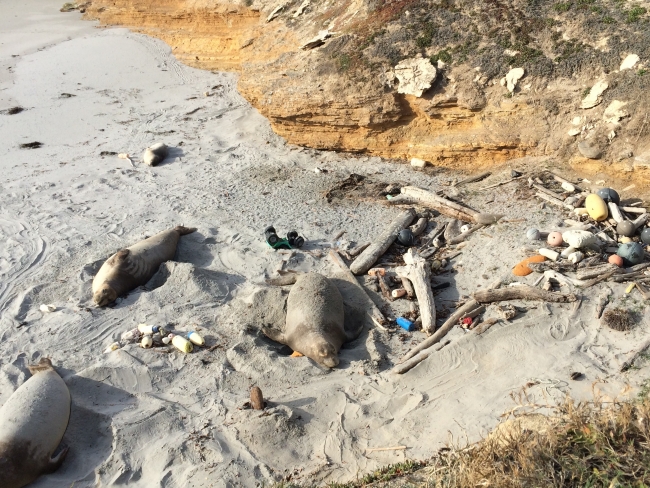By: Sherry Lippiatt, California Regional Coordinator for the NOAA Marine Debris Program
The Channel Islands offshore of Southern California are a special place with tremendous biodiversity and cultural significance, and home to the Channel Islands National Park and Channel Islands National Marine Sanctuary (CINMS). The islands are situated within 60 miles of 18 million people, yet receive relatively few human visitors, harbor 175 miles of undeveloped coastline, and provide habitat for numerous marine mammals, threatened birds, and other species unique to the area. Unfortunately, due to their location and orientation, the Channel Islands are also a local sink for marine debris that enters the Santa Barbara Channel.

The Channel Islands inevitably receive a lot of debris from the nearby, very densely-populated mainland. Local currents drive debris deposition on the islands, as the broad southward-flowing California Current interacts with the Southern California Countercurrent to create a dynamic, but typically counterclockwise, flow in the Santa Barbara Channel. These currents deliver land-based consumer items as well as debris lost by commercial shipping activities and local commercial and recreational fisheries. In particular, commercial spiny lobster traps are a particularly common sight.
The NOAA Marine Debris Program has two separate, but complementary projects intended to better understand and prevent debris impacting the Channel Islands. The first is a partnership with California State University Channel Islands (CSUCI) through our Community-Based Marine Debris Removal Grant Program. CSUCI staff and students from the Santa Rosa Island Research Station and the National Park Service are conducting marine debris removal and monitoring at a number of sites on Santa Rosa and Santa Cruz Islands, as well as engaging the local community through outreach to K-12 and undergraduate students, to support the cultivation of a community of Santa Barbara Channel stewards committed to preventing marine debris at the source. Check out the blog earlier this week or the project’s website profile for more.
Our second active project in the Channel Islands is a partnership with our NOAA colleagues at the Channel Islands National Marine Sanctuary. CINMS is working with veteran commercial spiny lobster fishermen to develop and share best management practices to prevent the loss of lobster traps. We are thrilled to share a great short film developed through this effort, Leave No Traps Behind: Best Practices to Prevent Lobster Trap Loss produced by Earth Media Lab (see video below; you can find the video transcript here). California Lobster fishermen will soon face trap tagging requirements under a new California Department of Fish and Wildlife Fishery Management Plan, so the timing is right to implement new voluntary practices to reduce the number of traps lost to fluctuating ocean conditions.
The Channel Islands have an incredibly rich history and ecology, driving many organizations dedicated to protecting this cherished place. Our hope is that these projects and the efforts of many others help us to better understand the local sources and types of debris, inspire the local community to get involved, and ultimately develop effective and targeted prevention efforts.





In the early '60s a Sea Scout our troop frequently visited Anacapa and Santa Cruz islands. We snorkled in our homemade wet suits, enjoyed the Abalone we caught by hand on our dives, and the fresh fish we speared with our surgical tube powered, hand spears. Out of short sighted ignorance we gave little regard to the long term impact of our behavior. HOWEVER, we never took more than we would consume that day, nor did we ever leave or toss trash. I can tell you from this first hand experience that there was NO plastic in the water or on the shore at that time. The phenomenon of plastic threatening to overtake sea life in volume and making the oceans uninhabitable is a result of our species behavior over the past 5 decades. It is heartening to learn of these initiatives. I hope to learn more and participate when available.